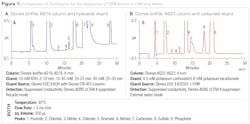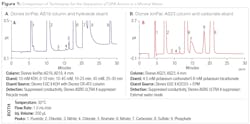Something in the Water
By Richard Jack, Jeff Rohrer, and Andy Eaton
With the increased use of non-gaseous forms of chlorine for the disinfection of drinking water, concerns over potential health impacts of exposure to disinfection byproducts (DBPs) like chlorate have generated a great deal of attention. This has resulted in chlorate earning a place on the U.S. Environmental Protection Agency’s (EPA’s) Contaminant Candidate List 3 (CCL3) and subsequently making its way into the Agency’s Unregulated Contaminant Monitoring Rule Three (UCMR3) program.
The most recent results from the ongoing UCMR3 program indicate that many drinking water utilities across the U.S. exceed the 210 μg/L health reference level for chlorate, and some even exceed the World Health Organization (WHO) guideline of 700 μg/L. Though the final decision to regulate chlorate is several years away, the current results suggest that chlorate will be a strong candidate for potential regulation in the U.S. and that many utilities could have a compliance issue.
Sources of Chlorate
Chlorates may arise in drinking water from the use of chlorine dioxide as a disinfectant. While many water utilities now prefer to use ozone, there are several that still use less effective methods such as ultraviolet light or chlorine dioxide. The latter may rapidly decompose into chlorite, chlorate and chloride, even in treated water. Beyond disinfection practices, sources of chlorate in drinking water may also include bleaching agents used in the pulp, paper and textile industries as well as in flour processing. According to the U.S. Food and Drug Administration (FDA), chlorine dioxide is considered a food contact substance while sodium-chlorite-based systems are used for antimicrobial applications in poultry, fruit and vegetable processing.1
Chlorate may also be introduced into the environment through its use as a non-selective herbicide for several crops.2 However, because it is unlikely to adsorb to soil, it has a high run-off potential, which could have a significant impact on waterways.
Toxicity
Consumption of high levels of chlorate can rupture erythrocyte cell membranes, impairing the blood’s ability to carry oxygen. This is followed by the irreversible formation of methemoglobin by oxidation of free hemoglobin in the blood. Levels of sodium chlorate as low as 600 mg of chlorate ions per kg of body weight can be lethal.3 Chlorate has also been shown to induce chromosomal damage to plant systems4 and thyroid gland neoplasms in rats.5 With such consequences, chlorate levels need to be accurately monitored.
Chlorate Prevalence and Regulation
The U.S. EPA has established the Unregulated Contaminant Monitoring Rule (UCMR) program to collect data for suspected contaminants in drinking water that do not have health-based standards under the Safe Drinking Water Act (SDWA). Every five years the EPA develops a new list of UCMR contaminants with data for the next cycle of the UCMR (UCMR3) to be collected throughout 2016. UCMR3 will study lower levels of chemicals than in previous cycles with minimum reporting levels (MRLs) based on analytical capabilities rather than biological impact, which are often below current health reference levels (HRLs).
The MRL for chlorate used for UCMR3 is conservatively established at 20 μg/L and the HRL is 210 μg/L. The EPA has set a daily reference dose of 0.03 mg per kilogram of body weight (0.03 mg/kg/day).
Chlorate data from the UCMR3 program to date (see Table 1) includes almost 55,000 samples from 4,749 public water systems (PWS), with many exceeding the MRL and HRL concentrations. In fact, 37 percent of PWS and nearly 15 percent of overall samples have chlorate above the reference concentration. This is a far higher percentage than any other contaminant measured in previous UCMRs, suggesting that many people could be drinking water with higher than recommended chlorate levels.
High levels of chlorate are linked to the type of disinfectant used by the water system, with those using bulk hypochlorite or onsite generation of hypochlorite experiencing more frequently elevated chlorate levels than those using more effective (but more costly) chlorine gas. Regardless of which method is selected, the production of high levels of chlorate occurs whether the facilities are using free chlorine or chloramines, and is more related to the source of the chlorine itself than the disinfection practice.
Chlorate Determination
It is not currently possible to remove chlorate ions once they have formed in drinking water, so detecting trace amounts of chlorate is imperative and there are many global regulatory methods available. The EPA 300.0 and 300.1, ISO 15061, and ASTM D6581 methods all use ion chromatography (IC) with suppressed conductivity detection.
EPA Method 300.0 is recognized as the standard IC method for inorganic anion analysis of reagent, ground, surface, drinking and wastewaters. This method specifies the use of a manually prepared carbonate eluent, a Thermo Scientific™ Dionex™ AS9 column and suppressed conductivity detection. This achieved a method detection limit (MDL) of 3 μg/L chlorate in reagent water (7.1 minute retention time).
A subsequent revision, EPA Method 300.1, employs a higher capacity analytical column6, achieving MDLs as low as 0.78 μg/L under high ionic strength water (HIW) conditions. Since the method was written over 15 years ago, hydroxide eluents have also been demonstrated to meet its requirements. Both eluents can be manually prepared or electrolytically generated using a reagent free ion chromatography (RFIC) system.
Improving on EPA Method 300.1 column and eluents
Recent advances in column technology offer new detection options. High-capacity anion-exchange columns mean more anionic mass can be loaded on the column, allowing for easier detection of trace anions such as chlorate in the presence of common interfering anions like chloride, carbonate and sulfate. The Thermo Scientific™ Dionex™ IonPac AS23 column, for example, was developed using a unique polymer technology to achieve a capacity of 320 μeq/column (4 x 250 mm column).
Hydroxide eluents have also proven effective in the determination of trace DBPs in drinking water. When using carbonate eluents, the suppression product is carbonic acid, which is less conductive than carbonate but still contributes to background conductance, lowering sensitivity. On the other hand, the suppression product of hydroxide is water, lowering background conductance and improving analyte sensitivity. A hydroxide-selective column (Thermo Scientific™ Dionex™ IonPac AS19) has been shown to meet or exceed the requirements of Method 300.1.
Reagent-Free Ion Chromatography Systems
EPA Methods 300.0 and 300.1 have traditionally used a manually prepared eluent; however, analytical sensitivity and reproducibility have been demonstrated to improve with an RFIC system. This eliminates the need to manually prepare and degas the eluent by combining electrolytic eluent generation with self-regenerating suppression. By electrolytically producing high-quality eluents from deionized water, RFIC systems have demonstrated improved performance for trace DBP detection. Recently, the IonPac AS23 column has been used to determine trace concentrations of chlorate, bromate and chlorite in drinking water7, showing how electrolytically-generated hydroxide eluents facilitate improved separation and limit of detection (see Fig. 1). Additionally, precise control of current allows repeatable concentrations and gradients for enhanced reproducibility. Hydroxide eluents generated on-line from deionized water automate a laborious task, improving both ease-of-use and reproducibility between analysts and laboratories.
Conclusion
Over the past 20 years, chlorates and other DBPs have been closely monitored and regulated due to their known toxicity. In order to assess their prevalence and formation, robust and sensitive analytical methods need to evolve so that monitoring is easy and straightforward. In this way, confidence in prevalence can be established so that sensible regulatory determinations can be made. Because the ionic strength of drinking water can vary, monitoring at low μg/L levels can become challenging. Ion chromatography has been demonstrated as a versatile technique for compliance monitoring of chlorate and other DBPs in drinking water. Through the use of suppressed conductivity detection, IC has been proven as an effective technique for chlorate detection and has been validated and approved by the EPA for compliance monitoring.
About the Authors
Richard F. Jack is the director of environmental and industrial vertical marketing at Thermo Fisher Scientific Inc. He works with regulatory agencies around the world to develop analytical methods compliance monitoring. Richard is a co-author for EPA 557 and has also drafted several ASTM methods.
Andy Eaton is the technical director and vice president for Eurofins Eaton Analytical Inc. His laboratory has been performing UCMR monitoring for more than 400 utilities across the country and for USEPA since 2001. Andy has numerous publications and presentations on UCMR and DBP monitoring.
Jeff Rohrer is the director of applications development for Dionex products at Thermo Fisher Scientific. He advises and reviews the work of other chromatography labs at Thermo Fisher Scientific. He has authored 70 peer-reviewed publications.
References
1. United States Food and Drug Administration, “Chlorate Environmental Assessment,” 2011.
2. Pesticide Management Education Program, “A Pesticide Information Project: Sodium Chlorate,” EXTOXNET, 1995.
3. Sheahan, B.J., et al., “Experimental sodium chlorate poisoning in dogs.,” Res. Vet. Sci., vol. 12, no. 4, (2005) 387-9.
4. Feretti, D., et al., “Evaluation of chlorite and chlorate genotoxicity using plant bioassays and in vitro DNA damage tests.,” Water Res., vol. 42, no. 15, pp. (2008) 4075-82.
5. “Toxicology and carcinogenesis studies of sodium chlorate (Cas No. 7775-09-9) in F344/N rats and B6C3F1 mice (drinking water studies).,”Natl. Toxicol. Program Tech. Rep. Ser.,(2005) 517: 1-255.
6. United States Environmental Protection Agency, METHOD 300.1 Determination of Inorganic Anions in Drinking Water by Ion Chromatography - Revision 1.0, 1997.
7. DeBorba, B., and J. Rohrer, “Determination of Trace Concentrations of Chlorite, Bromate, and Chlorate in Bottled Natural Mineral Waters,” Thermo Fisher Scientific Application Note 184, 2015.
More WaterWorld Current Issue Articles
More WaterWorld Archives Issue Articles


